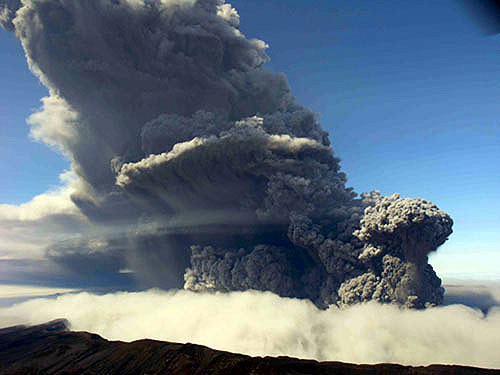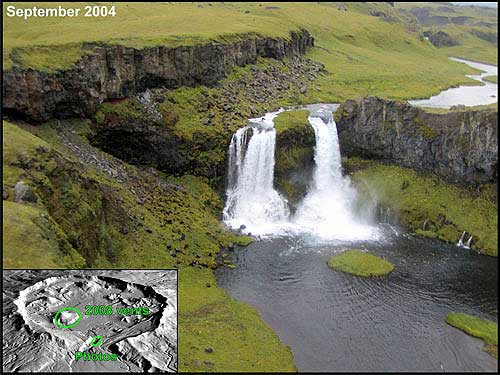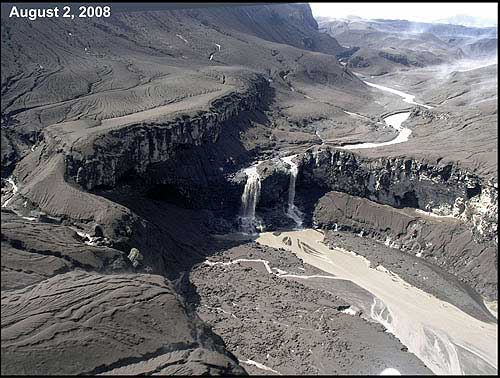 By NED ROZELL September 11, 2008
During the last decade, Larsen has spent days and weeks of her life-totaling about six months-on the island, making the green Aleutian landscape one of the most enduring in her mind's eye. A volcanologist with the Geophysical Institute at the University of Alaska Fairbanks and the Alaska Volcano Observatory, Larsen's trips to the island were to study the eruptive history of Okmok volcano. Then, on July 12, Okmok blew an ash cloud 50,000 feet. Rising molten rock met the water of a lake, turning some of the green island into a moonscape.  Photo by Jessica Larson, Alaska Volcano Observatory/Geophysical Institute.
Larsen remembered the upper reaches of Crater Creek, with waterfalls flowing down from a crater, lupines that held water droplets, and the melancholy songs of Lapland longspurs, snow buntings, and white crowned sparrows. Things had changed when she surveyed the island by helicopter recently. "The sentimental side of me is sad because the flowers are covered with ash now, but the scientist is excited," she said. "The opportunity is once in a lifetime." Janet Schaefer is a geologist with the Alaska Division of Geological and Geophysical Surveys whose work is funded by the Alaska Volcano Observatory. Like Larsen, she visited the island shortly after the eruption and saw a familiar place in a darker shade. "It was one of my favorite spots in Alaska," she said of "the Gates" region where Crater Creek leaps from two waterfalls from the old caldera of Okmok Volcano. "It turned from this heaven on Earth with beautiful tundra flowers and a waterfall to this black, devastated gates-of-hell kind of place."  Photos/illustration by Janet Schaefer, Alaska Volcano Observatory, Alaska Division of Geological and Geophysical Surveys.  Photos/illustration by Janet Schaefer, Alaska Volcano Observatory, Alaska Division of Geological and Geophysical Surveys. After having spent weeks on the island sampling volcanic rocks to tease out the nature of past eruptions, Schaefer said seeing the massive power of a volcanic eruption was jarring. "To see it just exploding is pretty crazy. We saw a wall of jetting ash and steam over a mile wide, sending dark gray ash and white steam clouds to almost 20,000 feet," she said. "The amount of energy released there is incredible to witness, and this compared to the caldera-forming eruption is nothing-just a little burp." Okmok has a crater that measures six miles from rim-to-rim; it was made during the cataclysmic event, about 2,000 years ago, and half a dozen pimples of smaller cones nest within the large crater. One of those, "Cone D," is most likely the source of the 2008 eruption. While "the Gates," formed by the drainage of a crater lake, will not be the home of songbirds for a while, that Aleutian paradise was ash-free for a relatively short time. In 1817, a similar eruption coated the island with ash and destroyed an Aleut village on the coast. Okmok's 2008 eruption is another reminder that nothing remains the same, especially on a volcanic island. "In a couple hundred years, somebody will be seeing flowers there again," Schaefer said.
Ned Rozell [nrozell@gi.alaska.edu] is a science writer at the institute. Publish A Letter in SitNews Read Letters/Opinions
|